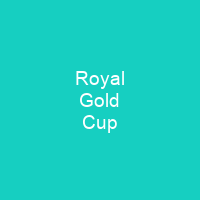The Royal Gold Cup: A Timeless Gem in History
Imagine a treasure so exquisite that it has survived centuries, passing through the hands of kings and queens, only to find its final resting place in the British Museum. The Royal Gold Cup, also known as the Saint Agnes Cup, is such a gem. This solid gold covered cup with enamel and pearl decorations was crafted for the French royal family at the end of the 14th century, making it a true masterpiece of medieval craftsmanship.
The Origins and Early History
When did this magnificent piece come into existence? The cup first appears in an inventory from 1391 belonging to Charles VI of France. It was given by John, Duke of Berry, Charles VI’s uncle, on his journey to Touraine in 1391. But who were the artisans behind such a stunning creation? King John II’s goldsmiths, specifically Louis of Anjou, are credited with its making. Louis was passionate about goldsmithing and this cup is just one of many exquisite pieces he created during his time.
The Cup’s Journey Through History
After Charles VI, the cup made its way through various royal collections in England before being in Spain for nearly 300 years. It was finally acquired by the British Museum in 1892 with a custom-made leather case, complete with iron lock and handles. The cup’s journey is as fascinating as its creation, reflecting the political and cultural exchanges of the time.
Design and Decoration
The Royal Gold Cup stands at an impressive height of 23.6 cm and has a diameter of 17.8 cm, weighing in at 1.935 kg. The cover can be lifted off, but sadly, the triangular stand is lost. The stem was extended twice by cylindrical bands, changing its original shape. The gold surfaces feature basse-taille enamel with translucent colors, scenes from Saint Agnes’ life, and Tudor roses.
At the foot of the cup are scenes of the Four Evangelists, while inside there are enamel medallions. The decoration includes large areas of translucent red (rouge clair) and intricate pointillé work. The lower band contains Tudor roses on a diapered background added under Henry VIII. This intricate design tells stories from Saint Agnes’ life, blending medieval iconography with contemporary elements.
Iconographic Details
The cup’s decoration follows the traditional story of Saint Agnes and her foster-sister Saint Emerentiana from the Golden Legend of Jacobus de Voragine. The scenes depict their return from school, their encounter with Procopius who falls in love with Agnes, her rejection of him, her martyrdom for refusing to sacrifice to Vesta, and her subsequent rescue by an angel. These stories are set in 14th-century Rome but feature contemporary dress, adding a unique twist to the narrative.
Historical Context
The cup was used as a ciborium for consecrated hosts and was exempt from church rules forbidding decorated vessels. Its creation is likely shortly before its appearance in Charles VI’s inventory in 1391, according to Ronald Lightbown. The construction techniques include basse-taille enamel areas, modeled with chasing tools to create different intensities of color when translucent enamel was applied.
The technique used for the cup’s decoration was known to the Ancient Romans but lost until the 17th century. It involves applying finely ground glass paste to recessed areas and firing it, creating a see-through effect like stained glass. Different colors blend at boundaries using a retaining border of gum tragacanth, achieving gradual blends through tints on base shades before firing.
Acquisition and Preservation
The cup arrived at the British Museum with a custom-made leather case, made with iron lock, handles, and mounts, featuring incised foliate decoration and a blackletter inscription: ‘YHE SUS O MARYA O MARYA YHE SUS.’ = Provenance = There is no firm evidence as to the date and circumstances of the cup’s creation. It was sold by nuns in 1882, removing some decorations, to gain a better price in Paris.
Baron Jérôme Pichon bought it after researching its authenticity but the Duke of Frías sued to recover it. Pichon’s research helped him buy the cup for £8,000 to the British Museum in 1891. The museum raised funds from various contributors, including Sir Henry Tate, to complete the purchase.
Conclusion
The Royal Gold Cup is not just a piece of history; it’s a window into the past, reflecting the artistry and craftsmanship of medieval times. Its journey through royal hands and its eventual home in the British Museum tell a story of cultural exchange and preservation. The cup stands as a testament to the enduring beauty and significance of such treasures.

You want to know more about Royal Gold Cup?
This page is based on the article Royal Gold Cup published in Wikipedia (retrieved on November 28, 2024) and was automatically summarized using artificial intelligence.







